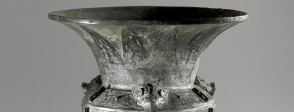Ask the students to bring from home containers used for the cooking and serving of food and drink. Investigate them, thinking about what materials are used, exactly how the containers are used, how the design matches the function and whether they are everyday or special objects. Then look at the zun and the other vessels in A bigger picture and consider the same questions.
Use the British Museum’s Ancient China website to find out more about tombs and ancestors. The website includes an interactive exploration of an early Chinese tomb and a Challenge where students select suitable objects to go into a tomb.
With the Challenge section in the British Museum’s Ancient China website as a starting point, ask the students to design the contents of a similar tomb using modern objects. Discuss why they have chosen what they have and ask them to consider how these objects would appear to an archaeologist who excavates them 3000 years in the future. Would the modern objects survive as well as the ones from the Shang tombs have?
Here are some activities and enquiries focusing on other aspects of the zun.
What was the zun used for? Who used it? What does this tell us about ancient Chinese beliefs about the afterlife? Do Chinese people still believe in the importance of ancestors today, 4000 years later? Do they still make offerings to them?
Investigate how the bronze zun was made. Use the diagram of how the piece-mould method worked and the video from the Asian Art Museum in San Francisco in About the object. Use a simple object and your own chosen modelling material to make simple piece-moulds to demonstrate the technique.
The zun and other ritual vessels are very sophisticated both in shape and in decoration. Ask students to invent a new ceremony or choose one they are familiar with. Then invite them to think how a vessel might be used in this ceremony and then to design their own vessel. Think about function, materials, size and decoration. Compare with the zun. Compare also the 19th century porcelain gu in For the classroom.
Look closely at the gui, ding, hu and jue in A bigger picture. You will see different forms of the same monster mask decoration, called a tao tie mask. We do not know precisely what it means, but it is found on bronze vessels right through the Bronze Age. Make a list of some mythical creatures from different cultures. What do the students think they mean? Why do so many cultures use animals like this? Ask them to think of a monster that symbolises an idea and to design a mask of the creature.
The following questions aim to encourage broader historical enquiry.
When was the Bronze Age?
The Chinese Bronze Age began around 2000 BC. How does this compare with the Bronze Ages of other ancient civilisations? Create a timeline showing these different dates. How do they compare? Is there any evidence that one influenced the development of any of the others?
How did bronze change societies?
Consider aspects such as the need for access to increasing amounts of mineral resources which may not have been available close to home and the technology needed to extract the metals, make the bronze and then make objects. Students might also look at the growth of population centres where wealth was concentrated and the development of social elites with control of and access to the metalwork.
Is history about the rich?
Most of the objects we find from Bronze Age cultures belonged to rich and powerful people. How does this affect our understanding of their societies? Why do we not find as much material belonging to ordinary people? Is it more important to know about the rulers or about the ordinary people?
How similar were early civilisations?
Compare the Shang tomb practices with burial traditions in other early civilisations such as Egypt and Mesopotamia. Investigate whether there were any connections between the cultures that would explain the similarities. What might any similarities tell us about fundamental human attitudes to life and death? Compare other aspects of civilisation to see how different cultures dealt with similar situations.


